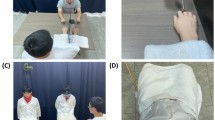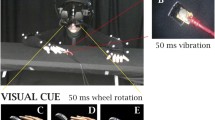Abstract
The experience of one’s body as one’s own is normally referred to as one’s “bodily sense of ownership” (BSO). Despite its centrality and importance in our lives, BSO is highly elusive and complex. Different psychopathologies demonstrate that a BSO is unnecessary and that it is possible to develop a limited BSO that extends beyond the borders of one’s biological body. Therefore, it is worth asking: what grounds one’s BSO? The purpose of this paper is to sketch a preliminary answer to the ‘grounding question.’ Thus, I begin by briefly presenting some contemporary competing hypotheses concerning the ‘grounding question’ and explain why they seem unsatisfying. Second, I discuss the “dual-aspect” of bodily awareness, which is manifest in every normal tactile experience and consists in a subject-object structure of awareness. I then argue that the “dual-aspect” of bodily awareness has the potential of explaining BSO and can, therefore, be considered its grounds. Taking the “dual-aspect” of bodily awareness as the grounds of BSO manages to escape difficulties faced by contemporary hypotheses concerning BSO, fulfills certain necessary demands upon any account of BSO, and explains relevant empirical findings and psychopathologies. Consequently, I argue that it is a hypothesis worth pursuing.
Similar content being viewed by others
Code availability
Not applicable.
Notes
See de Vignemont 2020. The Deflationary (Bermúdez, 2011) and the Cognitive (Alsmith, 2015) hypotheses will not be discussed here, both for reasons of space limitations and because they seem to deny, or remain uncommitted to the idea, that there is a phenomenology of bodily ownership to begin with (though there are exceptions to this generalization, see, e.g., Martin 1995).
There is even a third sense for “bodily awareness” (Sartre, 1986: 339; Moran 2010: 43–44): the scientific conception of the body. That is, the body as an idealized material object (e.g., the body as it is for the physician). However, since this conception of the body is irrelevant for our BSO, it will not be discussed here.
The use of tools in general is applicable here. For example, the case of a blind-cane is similar, in important respects, to the case of exploring a surface with a screwdriver’s tip to find a screw one has trouble seeing.
I am grateful to an anonymous reviewer for pointing out the importance of clarifying this part of the DA-hypothesis.
For instance, future investigations should investigate the differences between those who develop a limited sense of ownership and those who do not develop a sense of ownership at all, given the instantiation of only one aspect of DA of bodily awareness in the relevant body part.
References
Alsmith, A. (2015). Mental activity & the sense of ownership. Review of Philosophy and Psychology, 6(4), 881–896
Bermúdez, J. L. (2011). “Bodily awareness and self-consciousness. In S. Gallagher (Ed.), Oxford Handbook of the Self (pp. 157–179). Oxford: Oxford University Press
Bottini, G., Bisiach, E., Sterzi, R., & Vallar, G. (2002). Feeling touches in someone else’s hand. Neuroreport, 13, 249–252
Burin, D., Livelli, A., Garbarini, F., Fossataro, C., Folegatti, A., Gindri, P., & Pia, L. (2015). Are movements necessary for the sense of body ownership? Evidence from the Rubber Hand Illusion in pure hemiplegic patients. PLoS One, 10(3), e0117155
Ehrsson, H. H., Katja, W., Nikolaus, W., Raymond, J. D., & Richard, E. P. (2007). “Threatening a Rubber Hand That You Feel Is Yours Elicits a Cortical Anxiety Response.” Proceedings of the National Academy of Sciences, 104(23): 9828–9833
Fiorio, M., Weise, D., Önal-Hartmann, C., Zeller, D., Tinazzi, M., & Classen, J. (2011). Impairment of the rubber hand illusion in focal hand dystonia. Brain, 134, 1428–1437
Husserl, E. (1989). Ideas Pertaining to a Pure Phenomenology and to a Phenomenological Philosophy, Second Book. Dordrecht: Kluwer: Trans. R. Rojcewicz and A. Schuwer
Husserl, E. (1997). Thing and Space (Lectures of 1907). Boston: Kluwer Academic Publishers
Imaizumi, S., Asai, T., & Koyama, S. (2017). Agency over phantom limb enhanced by short-term mirror therapy. Frontiers in human neuroscience, 11, 483
Jacobson, H. (2018). Not only a messenger: towards an attitudinal-representational theory of pain. Philosophy and Phenomenological Research, 99(2), 382–408
Marchetti, C., & Della Sala, S. (1998). Disentangling the Alien and Anarchic Hand. Cognitive Neuropsychiatry, 3(3), 191–207
Martin, M. G. F. (1995). “Bodily awareness: a sense of ownership.”. In J. L. Bermúdez, T. Marcel, & N. Eilan (Eds.), The Body and the Self (pp. 267–289). Cambridge, MA: MIT Press
Merleau-Ponty, M. (2012). Phenomenology of Perception. New York: Routledge. Landes, D. A. (Trans
Moran, D. (2010). “Husserl, Sartre and Merleau-Ponty on embodiment, touch and the ‘double sensation’.”. In K. J. Morris (Ed.), Sartre on the Body (pp. 41–66). London: Palgrave Macmillan
Moro, V., Zampini, M., & Aglioti, S. M. (2004). Changes in spatial position of hands modify tactile extinction but not disownership of contralesional hand in two right brain-damaged patients. Neurocase, 10, 437–443
Peacocke, C. (2017). “Philosophical Reflections on the First Person, the Body, and Agency.”. In F. de Vignemont, & A. Alsmith (Eds.), The Subject’s Matter: Self-Consciousness and the Body (pp. 289–310). Cambridge, MA: MIT Press
Peled, A., Pressman, A., Geva, A. B., & Modai, I. (2003). Somatosensory evoked potentials during a rubber-hand illusion in schizophrenia. Schizophrenia Research, 64, 157–163
Rahmanovic, A., Barnier, A. J., Cox, R. E., Langdon, R. A., & Coltheart, M. (2012). ““That’s not my arm”: A hypnotic analogue of somatoparaphrenia. Cognitive neuropsychiatry, 17(1), 36–63
Ratcliffe, M. J. (2008). Touch and situatedness. International Journal of Philosophical Studies, 16, 3: 299–322
Romano, D., Martina, G., Gabriella, B., & Angelo, M. (2014). Arousal Responses to Noxious Stimuli in Somatoparaphrenia and Anosognosia: Clues to Body Awareness. Brain, 137(4), 1213–1223
Sartre, J. P. (1986). Being and Nothingness. Routledge: London: Barnes. H. E. (Trans
Vallar, G., & Ronchi, R. (2009). Somatoparaphrenia: a body delusion. A review of the neuropsychological literature. Experimental brain research, 192(3), 533–551
de Vignemont, F. (2007). Habeas corpus: The sense of ownership of one’s own body. Mind & Language, 22(4), 427–449
de Vignemont, F. (2011). Embodiment, ownership and disownership. Consciousness and cognition, 20(1), 82–93
de Vignemont, F. (2018). Mind the Body: An Exploration of Bodily Self-Awareness. Oxford: Oxford University Press
de Vignemont, F. (2020). “Bodily Awareness”, The Stanford Encyclopedia of Philosophy, Edward N. Zalta (ed.), https://plato.stanford.edu/archives/fall2020/entries/bodily-awareness/
Zahavi, D. (2005). Subjectivity and Selfhood: Investigating the First-person Perspective. Cambridge, MA: MIT Press
Funding
Not applicable.
Author information
Authors and Affiliations
Corresponding author
Ethics declarations
Conflict of Interest
Not applicable.
Additional information
Publisher’s Note
Springer Nature remains neutral with regard to jurisdictional claims in published maps and institutional affiliations.
Rights and permissions
Springer Nature or its licensor (e.g. a society or other partner) holds exclusive rights to this article under a publishing agreement with the author(s) or other rightsholder(s); author self-archiving of the accepted manuscript version of this article is solely governed by the terms of such publishing agreement and applicable law.
About this article
Cite this article
Lotan, G. Grounding Bodily Sense of Ownership. Philosophia 50, 2617–2626 (2022). https://doi.org/10.1007/s11406-022-00554-4
Received:
Revised:
Accepted:
Published:
Issue Date:
DOI: https://doi.org/10.1007/s11406-022-00554-4




